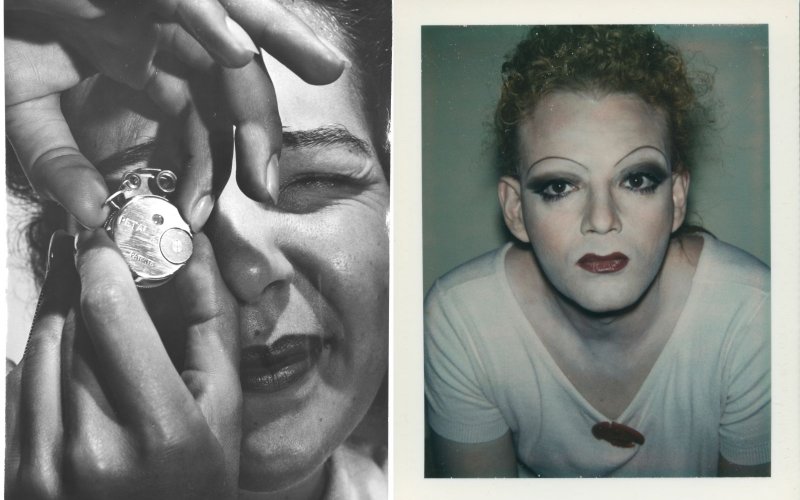New Exhibition opens in University Art Museum’s New Gallery

ALBANY, N.Y. (July 29, 2021) — The University Art Museum’s new Collections Study Gallery opens Aug. 4 with its first exhibition, “I’ll Be Your Mirror,” featuring works from the museum collection and pieces on loan from artist Dave McKenzie.
The new exhibition space was created from a remodeled second-floor office while the museum was closed to the public during the Covid-19 pandemic. The gallery will offer a rotating schedule highlighting artworks from the museum’s Fine Art Collections in tandem with past exhibiting artists and/or emerging or established contemporary artists.
“I’ll Be Your Mirror,” which will be open through Dec. 11, includes works by Andreas Feininger, Katria Foster, Rachel Foullon, Jenny Kemp, Mary Ellen Mark, Dave McKenzie, Edward Steichen and Andy Warhol, along with pieces on loan from McKenzie, who had a solo show at the museum in 2017.
“Mirror” focuses on the questions of who we are, what we aspire to be, and what we hide or reveal through iconic celebrity portraits shown alongside equally compelling portraits of anonymous, everyday people, abstract painting, sculpture and video.
Andy Warhol is central to the exhibition, with portraits of celebrities, including Jackie Curtis, whose gender performing acting career began in East Village drag; Jackie Kennedy at her husband’s funeral, serialized in a blue lithograph that captures the feeling of a nation in mourning; and Elizabeth Taylor as Cleopatra, a work that raises questions about role-playing, as well as a series of Polaroids of an unknown woman.
From Warhol, the exhibition extends both backward and forward in time. Classic portraits of actors Paul Robeson, Greta Garbo and Charlie Chaplain by Edward Steichen blur the line between acting persona and the self. Andreas Feininger’s 1949 photographs of people pointing their now-vintage cameras at his camera reflect their own time but also mirror today’s era of selfie-culture.
Dave McKenzie’s artwork returns to the Museum after his 2017 solo exhibition “An Intermission.” In one work, the arms and heads of seven women are reprinted onto an orange banner from a photograph that could have been taken at work, a party or a protest. A 2001 video captures the artist tracing the contours of an Andy Warhol portrait of Elizabeth Taylor on a steamy glass shower wall — an intimate space for reflecting on the artist’s identity within the artworld. This intimacy is echoed in Katria Foster’s photograph “Domestic Affair 6” in which an arm reaching out from a shower curtain is reflected in the vanity on the opposite side of the composition.
In 2018, the Museum unveiled its new Collections Study Space, a multi-purpose space designed to house more than 3,000 objects reflecting 50 years of modern and contemporary art – and make them accessible to students. The new Collection Study Gallery, as well as the Museum’s redesigned digital database, is a continuation of this mission.
Well/Being
In the Museum’s main space during the same time, Aug. 4 through Dec. 11, is “Well/Being: An Exhibition on Healing and Repair,” featuring artwork that addresses the complexities of daily life during the pandemic era. Twelve established and emerging artists and musicians present multi-disciplinary approaches to pandemic-related issues such as kinship, chronic illness, convalescence, intimacy, the emotional costs of caregiving, and various incarnations of love and community.
The works – by Panteha Abareshi, Sanford Biggers, Diedrick Brackens, Jeffrey Gibson, Tanja Hollander, Scott Keightley, Michelle Young Lee, Glendalys Medina, Amaryllis DeJesus Moleski, Emily Daggett Smith, Odessa Straub and Carrie Mae Weems – offer a response to the need for social and cultural spaces in which to pause, reflect and find solace. The exhibition includes new commissions, participatory workshops, performance and conversations to provide an environment in which visitors can experience forms of connection, resilience, action and hope in turbulent times.
The University Art Museum is open 11 a.m. through 4 p.m. Tuesday through Saturday. For the most up-to-date information on hours and visitor guidelines, visit the website or call (518) 442-4035.




